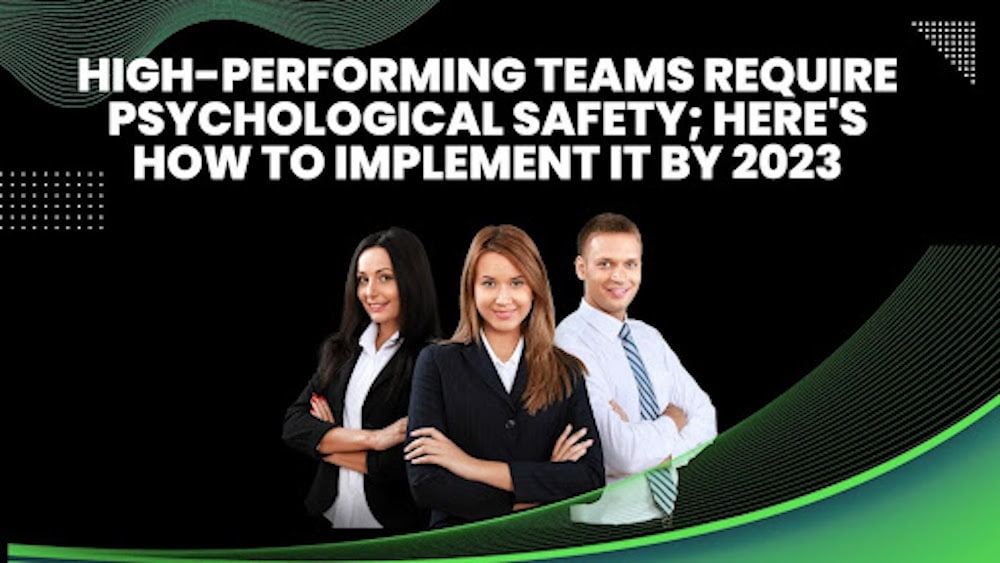Table of Contents
In a world of rapid change and constant disruption, companies that don’t have solid psychological safety are at risk of losing employees. Even the most productive, high-performing teams have their share of conflict, and handling those situations with care is important.
Leaders who want to create a high-performing team should strive to create an environment where each team member can trust each other and feel safe expressing themselves. The more open this environment is, the more likely it is that high-performing teams will form.
What Is Psychological Safety?
Psychological safety is a state of comfort where employees can express their thoughts and opinions openly. Employees can share their thoughts and ideas with their supervisors and coworkers when there is a psychologically safe workplace. They can do this without feeling judged or criticized for it.
A psychological safety workplace is a critical component of a high-performing team. By encouraging psychological safety within your team, you will increase the likelihood of your team being high-performing.
How Does Psychological Safety Affect My Business?
Psychological safety is your sense of comfort in your role, team, and organization. It can make all the difference in how well your business performs.
Psychological safety is key in determining employees’ motivation to do their best work. When people feel safe in their jobs, they’re more likely to be productive and make good decisions. In addition, they are more creative because they trust their team members to come up with solutions.
Employees who feel safe can take risks without worrying about losing their job or being disciplined for trying something new. They are also more likely to solve problems effectively when they trust their teammates. A successful business is built on mutual respect and trust between all employees, which allows everyone to make tough decisions together during stressful situations or crises.
How Leaders Can Implement Psychological Safety
Employees who feel safe are more likely to take risks and try various things. They also tend to show fewer symptoms of stress and fatigue from their jobs. This leads to better employee performance and higher engagement.
When there is a psychological safety workplace it helps employees perform at their peak. And it’s something leaders can create in their organizations with the right practices.
Here are some ways leaders can implement psychological safety:

1. Be a Collaborator, Not an Adversary
Conflict is part of life. It’s inevitable, and we all must deal with it in our jobs. But the best conflict is constructive and positive. Good conflict helps you solve problems, improve your team’s performance, and create a better organization.
There are two ways to approach conflict: as an adversary or as a collaborator. If you approach conflict as an adversary, your team will feel anxiety and tension in the room, and they will be more likely to shut down and avoid conflict altogether.
If you approach conflict as a collaborator, however, your team will feel safe and comfortable enough to talk about complex topics openly with each other. Collaboration allows individuals to see conflict as an opportunity to learn and grow rather than as a problem.
2. Communicate on a Human Level
Psychological safety is not about having fun, being nice to your employees, or being good. It’s about speaking human to human so they feel safe enough to be vulnerable and share their true selves with you.
Psychological safety is not something you can create overnight. It takes time for people to build trust in one another, and it takes time for them to learn how the other person might respond when they’re open with them. So you must demonstrate this kind of behavior immediately — especially if you’re new at communicating openly with your team members.
3. Encourage Participation and Ownership
Encouraging participation and ownership is one of the best ways to create a psychological safety workplace.
Encourage your team to participate in meetings and other key meetings. Invite them to add their thoughts on the topic. This will help the team make balanced decisions for the final product.
As a leader, make it clear that you want all team members to feel like they own what they do. This means they should take responsibility for their actions, decisions, and contributions. When people feel like they own their work, they are more likely to be motivated by this feeling. They will be willing to put in extra effort when needed.
4. Plan Countermoves in Advance of Reactions
The key to creating psychological safety workplace within your team is to anticipate the person’s reaction to your thoughts and ideas. So, if you’re not sure whether you should mention something, ask yourself, “What will happen if I do? How will this person react?”
When you anticipate someone’s response, you can think about what they might say or do next. This helps you prepare a countermove that will help build trust and create psychological safety (sometimes even lead to a successful idea).
5. Put Curiosity in Place of Blame
One of the biggest barriers to psychological safety is blaming others for mistakes, even when those mistakes were not their fault. It’s human nature: We all blame others when things don’t go our way. But if you want teams to perform at their peak, this is not an acceptable way of operating. By blaming your team, you leave them focused on what’s wrong with them instead of addressing the root cause. Instead, encourage curiosity in all forms: What do I need? How can I help? Why do I think this way?
6. Give Constructive Feedback
Feedback is an essential part of any professional learning experience. When you ask for feedback, it’s a sign that you value your team’s growth and development.
You disarm your opponent when you ask for feedback on delivering your message. You’re showing that the relationship is reciprocal; you are creating a psychological safety workplace where team members feel comfortable giving and receiving such feedback.
Conclusion
In the past few years, we have seen a lot of companies start to realize that high-performing teams are a necessity for the success of their business. In fact, this realization is becoming so widespread that it’s not just the big players implementing these practices.
Psychological safety helps people feel safe enough to be open and honest with each other and vulnerable enough to ask questions, make mistakes, and learn from feedback. Collaboration, creativity, and innovation are all possible when there is psychological safety at work across an organization.
Images via Canva


